Storylane is a fast-growing, YC-backed interactive demo software. If you find yourself here, then I'll assume a) you're familiar with them, and b) that Storylane might not be a fit for some reason.
Perhaps:
- Per-seat pricing is too expensive as your team grows
- Some features or integrations might be missing
- You want something fully dedicated to sales use cases
…Whatever the reason, here's 7 of their competitors that might make a suitable alternative.
Here are the 7 best alternatives to Storylane
- Navattic
- Supademo
- Walnut
- Reprise
- Tourial
- Arcade
- Lancey
Here's more about what they can do, pricing, and differences compared to Storylane.
1. Navattic

Best suited for: embedding an interactive demo on a website, or for sharing with prospects
Free trial: No, request a demo here.
Starting price: $500/month (or $300/mo startup plan is available for small teams of less than 20 employees.) See pricing.
Key features
Like Storylane, Navattic lets you build an interactive product demo without engineering resources.
While Storylane has a broader feature set, Navattic is more focused. They go deeper on core offerings (like complex HTML capture, and mid-market/enterprise customer success), while Storylane go broader (more features overall, more pricing options).
Navattic demos can be embedded onto a website, or used for any other purpose (e.g. to send directly to prospects async without needing a call).
It lets you create guided product tours, or a ‘choose your own adventure' style of demo with checklists & options for users to explore.
You can play around with their live interactive demo to get a feel for how it works.
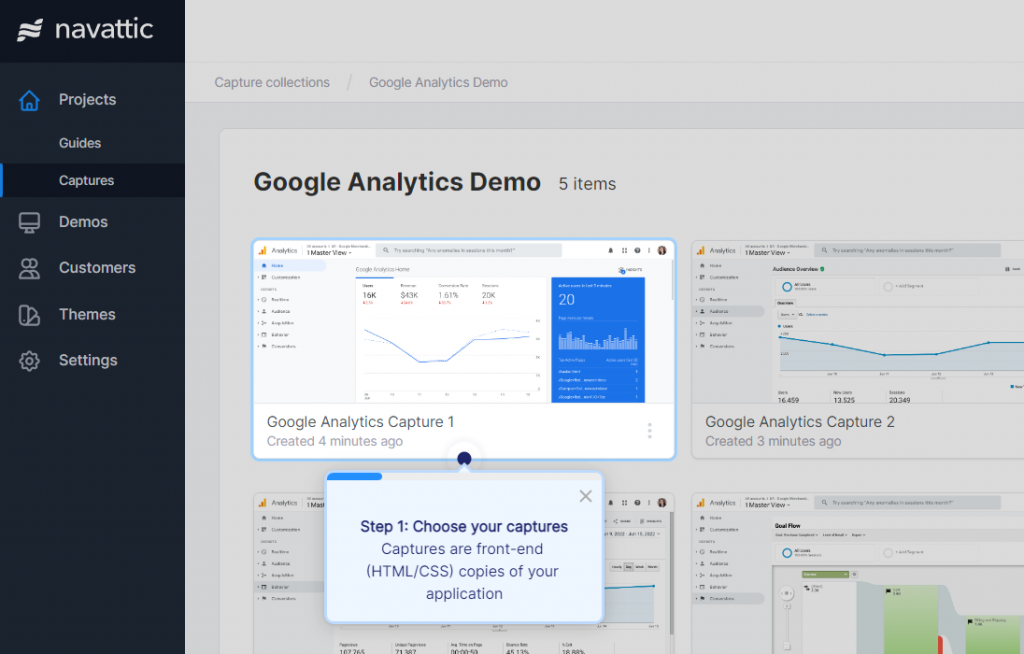
There are integrations with Hubspot, Salesforce, Marketo, Segment, Zapier, and GA4– making it easier to see how demo interactions impact metrics further down the funnel.
There's also Embed Events, which makes it easier to send events to tools like Mutiny, Mixpanel & other event-based analytics tools.

It's intuitive to use & fast to get a demo set up, even for non-technical people. Our marketing team at Modash (my full-time gig) recently started to use it.
Navattic vs Storylane
- Navattic has more published examples & experience with HTML capture overall
- Navattic has a higher starting price, but unlimited user seats on every plan
- Navattic have (arguably) a stronger, US-based customer success team
- Storylane enables a lower entry price using per-set pricing & a plan without HTML capture
- Storylane has more features overall (e.g. AI assist & video capture)
See a full Navattic vs Storylane comparison here.
Pricing
Navattic's base pricing is publicly available: $500 for ‘Base' (company size up to 100 employees & base features), and $1,000/month for larger companies, plus extras like SSO & dedicated success managers/coaching. View pricing page. Monthly plans from $600/month.
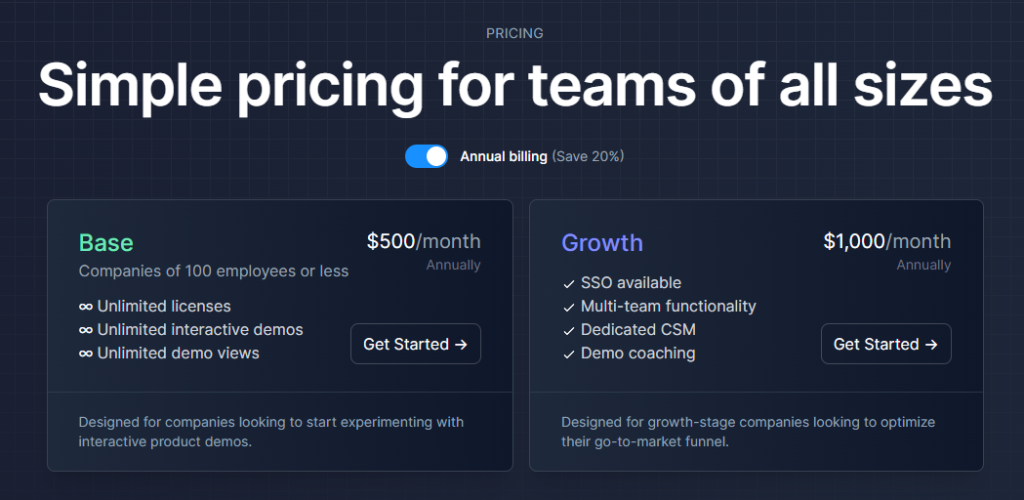
There is also a lower cost startup plan, and they can offer customized pricing.
2. Supademo
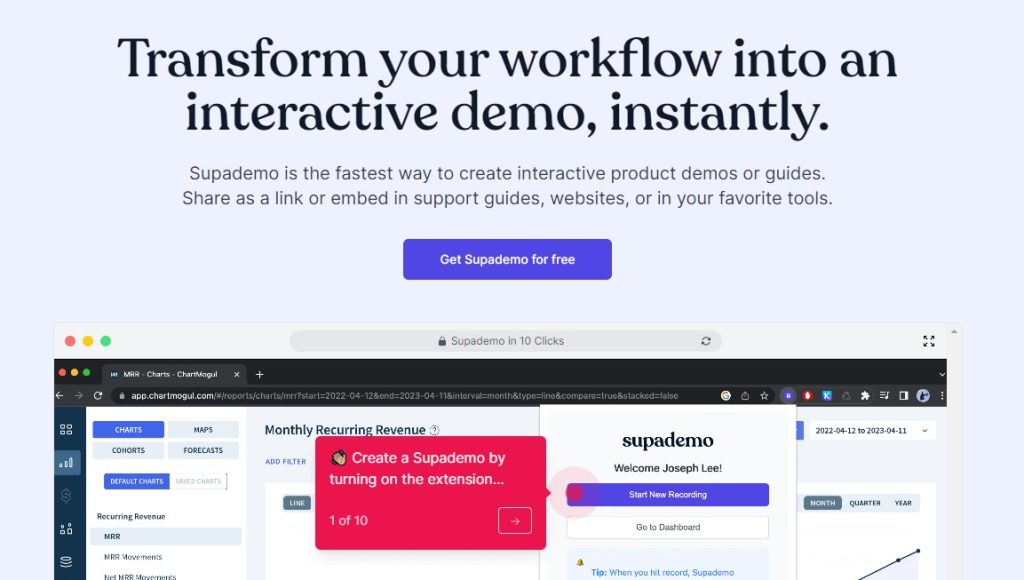
Best suited for: affordable tool for screenshot & video capture
Free trial: Free plan for up to 5 demos.
Starting price: Free, then $24/month per creator seat (unlimited demos).
Key features
Supademo offers a similar use case to Navattic (making interactive product demos), with a couple of key differences:
- t's a much cheaper solution, with a free version & monthly options
- It uses screenshot capture instead of HTML capture
- It comes without some of the bells & whistles (think integrations, some data, strategic support)
If you're looking for something simpler on a lower budget to implement your first interactive demos, Supademo is probably a good bet.
It uses a Chrome extension to capture screenshots & videos, and time-to-launch is fast.

One of the key drawbacks to using screenshots instead of HTML capture (like Navattic) is that you can't easily edit screens. With code, you can click into a text area to change it, adjust charts, blur stuff out etc.
Supademo solved that (in part — not entirely) with a recent update that enables annotations & editing, which is available on the higher pricing tier.

Supademo vs Storylane
- Supademo has a lower entry price and more generous free plan
- Both tools are in the minority within this space that have AI-assist features
- Storylane generally has more features overall, including lead capture forms
- Supademo uses only screenshot capture, while Storylane can do HTML too
Pricing
Supademo has a free version for 5 demos, and paid plans start from $24/month per creator seat & unlimited demos. Custom pricing is available for more seats and additional features.
3. Walnut

Best suited for: a Storylane alternative with a greater focus on serving sales/pre-sales teams in mid-market companies
Free trial: No. Request a demo here.
Starting price: Unknown.
Key features
While Storylane has a broad offering that covers small & medium businesses for marketing & sales, Walnut is more focused. Their entry price is higher, they only have annual plans, and they're more deeply focused on sales (and pre-sales) use cases.
Walnut captures your product's front-end using a Chrome extension, then enables either no-code editing, or HTML editing.
One unique feature of Walnut is that you can enable prospects to leave comments & questions directly inside the interactive demo, just like collaborating in a Google Doc or a Figma file — which makes for a more interactive sales experience.

Walnut is also strong in internal team collaboration, with all the basics covered: access/permissions, various sharing settings, and ways to tag/group demos internally.
Plus, you can create demo templates & save into a shared library. With those templates, anyone in the team can then quickly find a template, understand what it's used for, and reuse it for their use case.

Walnut offers analytics features to help you check who has used your demos, for how long, their completion rates & more.
It has integrations with Salesforce & Hubspot, but lacks a couple of others (e.g. Google Analytics, Zapier, Segment).

See also: Walnut alternatives.
Walnut vs Storylane
- Storylane offers a self-serve option to start, and more accessible starting price
- Storylane has more one-click CRM integrations (e.g. Walnut is missing Marketo, Clearbit)
- Both tools let you cover the basic marketing & sales use cases
- Walnut's feature set & positioning is more focused around sales / pre-sales
- Walnut has a Google Docs-style comments in demos collaboration feature which Storylane lacks
Pricing
Walnut determines its pricing based on user seats. Every plan comes with unlimited demos created and unlimited demo views.
4. Reprise

Best suited for: 300+ size teams with comprehensive needs for both marketing & sales demos
Free trial: unknown. Request a demo.
Starting price: unknown.
Key features
Reprise offers a versatile demo creation platform that you to build three types of demos: product walkthroughs, plus live demo overlays for sales, and complete explorable sandbox environments to give to prospects.
This versatility makes Reprise particularly useful for organizations that need a unified platform for their sales and marketing teams, and have the budget for a more expensive platform.
They're built for enterprise, and focus on team sizes of 300+.
Reprise also has enterprise-grade security, including being one of the earliest platforms in this space to get SOC 2 type 2 certified, and having a dedicated in-house Direct of Information Security.
You can see an example of an interactive demo made with Reprise here.
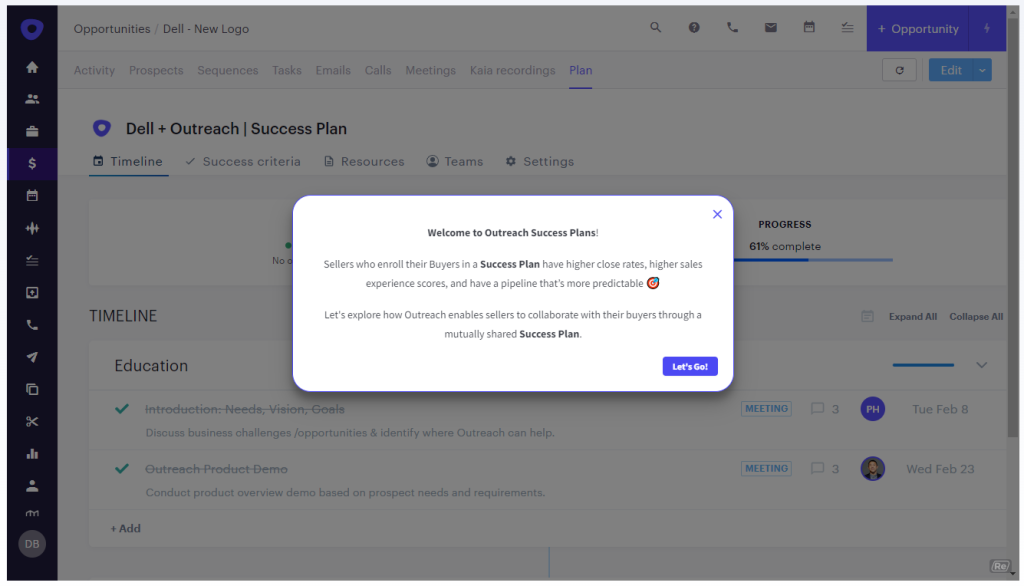
The platform also includes native integrations with analytics tools such as Google Analytics, Salesforce CRM, or Hubspot Analytics.
Typically, Reprise customers would report a longer time-to-value to get set up initially compared to similar platforms. Once everything is in place, though, it gets much faster to replicate your demo templates (e.g. an AE can prepare for a sales call quickly).
Reprise vs Storylane
- Reprise starting price is a lot higher, with only annual plans
- Storylane is more scalable and accessible, catering for SMBs and mid-market
- Reprise as an organization are more focused on handling the largest enterprise deals
See also: Reprise alternatives.
Pricing
Reprise pricing isn't publicly available; get a tailored quote by requesting a demo. Unlike Storylane, Reprise does not offer a way to try free self-serve.
5. Tourial

Best suited for: creating interactive demos for marketing use cases with screenshots/videos
Free trial: No, request a demo here.
Starting price: $790/month (paid annually). See pricing.
Key features
Tourial is another interactive demo software, but it's unique positioning is their Demo Center offering.
As well as creating product tours like all the other products in this list (with screenshot/video only), this feature lets your champion create customized tours for their team.
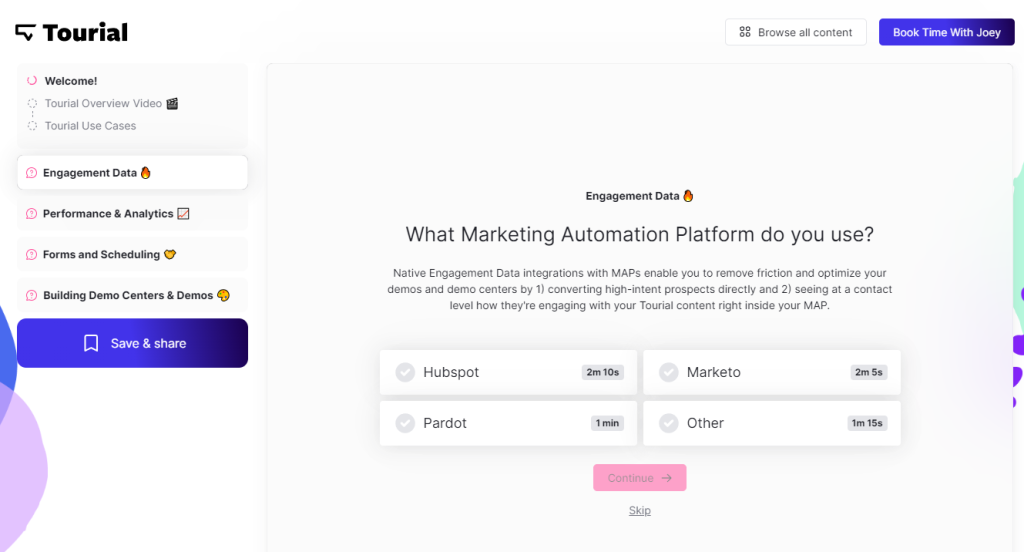
It lets you pick & choose which features are important to include within the demo, then generates a shareable link to circulate within your team.
Tourial uses screenshots & video capture, while Storylane is capable of both. The screenshot method is suitable for handling:
- Lots of complex workflows → you can add video captures to save on click fatigue
- Mobile apps & mobile traffic (it's much easier to mobile optimize)
- Lots of JavaScript functionality → HTML capture will miss actions e.g. drag n drop
But, you might miss not being able to use HTML capture if you want to be able to easily click & change text, data, & edit the UI to customize the demo screens exactly how you'd like them.
Tourial vs Storylane
- Tourial uses screenshot capture, while Storylane can offer both screenshot/video & HTML
- Storylane's entry price is much lower, but since Tourial offers fixed prices with unlimited seats, it can be more economical for larger teams
- Tourial's Demo Center feature is a unique offering
- Storylane has some features Tourial doesn't (e.g. AI assist)
Pricing
Tourial offers 1 simple base platform package that comes with unlimited demos, user seats, demo views, integrations, forms, support, and Demo Centers. View full plans page here.
Their Startup package is available for companies with < 50 employees and includes all features, onboarding, and digital support.
6. Arcade

Best suited for: marketing teams in need of marketing demos that can easily be embedded onto websites, blogs, and social media.
Free trial: offers a freemium model. Sign up here.
Starting price: Free. Paid plans from $38 per month.
Key features
Arcade is quite similar to Supademo, in that it uses screenshots/videos, but has a slightly more mature set of features.
The tool works in the same way, fundamentally — by capturing screens with a Chrome extension.
A couple of notable differentiators:
Arcade lets you integrate video, like other tools, but it also supports audio. For example, to explain a feature, or just build trust by showing your face.

The higher pricing tier includes built-in video editing features (e.g. speed up, trim) to streamline your demo creation workflow, white labeling, and team collaboration features.
Like Storylane, Arcade lets you start small and grow into more features.
Arcade vs Storylane
- Arcade uses screenshots & video, Storylane can also offer HTML capture (at a higher price)
- Both tools have monthly plans & relatively accessible entry pricing
- Both tools bill per seat
- Storylane has more integrations overall
Pricing
Arcade uses a freemium model, with the free version letting you create up to three publicly shared demos. Paid plans start from $32/user/month, and some features are locked into higher pricing tiers.
7. Lancey.io

Best suited for: a similar tool with fewer features overall, but unlocks HTML capture at a lower price
Free trial: Yes, 14 days. Sign up here.
Starting price: Free. Paid plans from $36month (monthly) or $29/month (billed annually) per seat.
Key features
Lancey is a newer entrant to the category, with a growing feature set.
It has flexible pricing plans, which let you start small & grow into features like personalization & audio overlays.
Notably, Lancey enables HTML capture starting from a lower price. With Storylane, you can't use this capture method for less than $100/seat/month. With Lancey, it's available in the free version & paid versions from $29/seat/month.
You can see an interactive demo made with Lancey on their product page.

Some things you might want to know:
- Lancey has a fast time-to-value, including a self-serve offering & free trial
- There are features available for personalization, and AI text-to-speech for audio overlay — but these aren't on the entry pricing plan
- As an earlier stage product, some features & integrations might be missing. For example, Segment & Zapier is missing
- There's no ‘choose your own journey' that Storylane, Navattic & others have like branching & checklists
Overall though, it's a clean & accessible product with all the core offerings that you may want to consider.
Lancey vs Storylane
- Both tools bill per user seat and have relatively accessible pricing
- Lancey enables HTML capture on all plans, whereas this is $100+ in Storylane
- Storylane has more native integrations (e.g. Clearbit, Segment, Zapier)
- Storylane has more customizable lead forms
Pricing
You can publish 1 demo for free.
Paid plans start from $29 per month per seat.
Final thoughts on Storylane competitors
If you're looking at Storylane alternatives for a marketing use case, I'd consider looking at:
- Mature tools (comparable costs): Navattic, Tourial, Arcade
- Newer tools (lower costs): Supademo, Lancey
Or if you need to cover sales demos too, look at Walnut, or Reprise.
